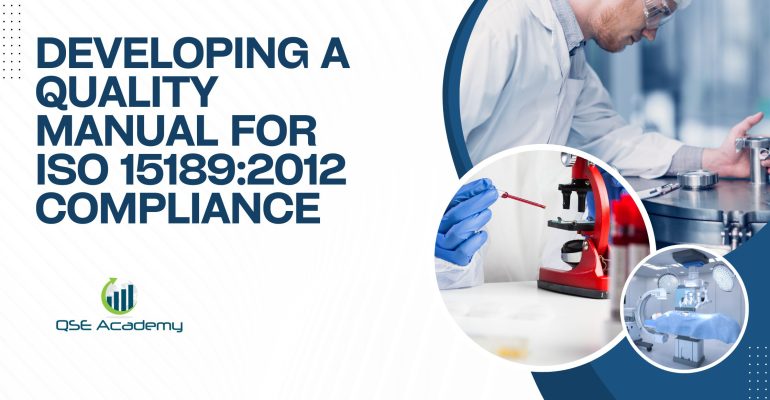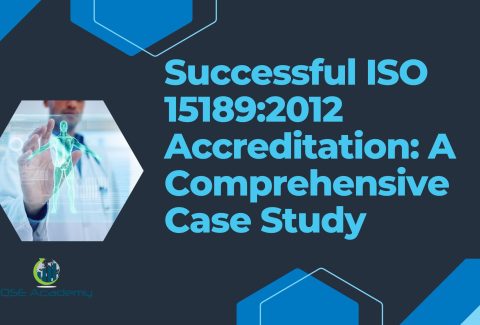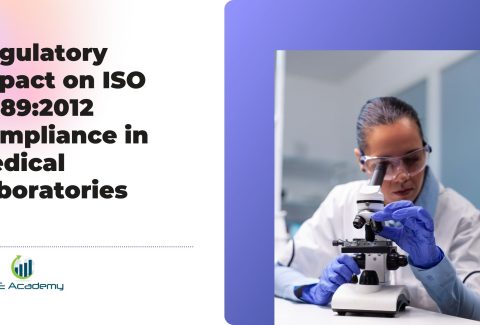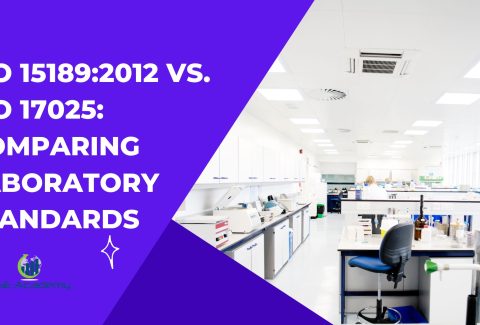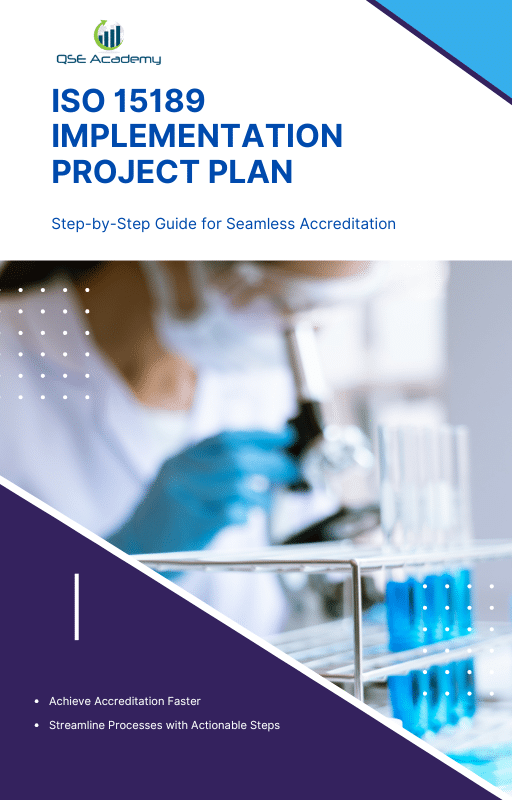Entwicklung eines Qualitätshandbuchs zur Einhaltung der ISO 15189:2012
Die Schaffung des Eckpfeilers für hervorragende Laborleistungen beginnt mit der Einhaltung international anerkannter Normen. Die ISO 15189:2012, die speziell für medizinische Laboratorien gilt, verlangt ein umfassendes Qualitätshandbuch, um gleichbleibend hochwertige Prozesse und Dienstleistungen zu gewährleisten. Der Weg zur Konformität ist komplex, aber ein gut aufgebautes Handbuch dient sowohl als Kompass als auch als Karte.
Das Verständnis der Feinheiten eines Qualitätshandbuchs ist für Laboratorien, die die ISO-Norm 15189:2012 erfüllen wollen, von entscheidender Bedeutung. Dieses Dokument ist nicht nur eine Anforderung - es ist die Verkörperung des Engagements eines Labors für Qualität. Durch die Anpassung der Richtlinien und Verfahren an internationale Benchmarks zeigt ein Labor seine Leistungsfähigkeit und Zuverlässigkeit.
In den folgenden Abschnitten gehen wir auf die Feinheiten bei der Erstellung eines Qualitätshandbuchs ein, das nicht nur die strengen Anforderungen der ISO 15189:2012 erfüllt, sondern auch ein Umfeld für Spitzenleistungen fördert. Vom Zweck und den Kernelementen des Handbuchs bis hin zur kontinuierlichen Verbesserung und zum Risikomanagement werden in diesem Leitfaden die wesentlichen Schritte erläutert, mit denen Labore ihre Konformitäts- und Qualitätsziele erreichen und aufrechterhalten können.
Einführung
ISO 15189:2012 ist eine wichtige Norm, die speziell für medizinische Laboratorien entwickelt wurde. Sie setzt strenge Maßstäbe für Qualität und Kompetenz und konzentriert sich auf die konsistente und zuverlässige Lieferung genauer Testergebnisse, die für die Patientenversorgung von entscheidender Bedeutung sind. Die Norm umfasst Managementanforderungen ähnlich der ISO 9001 und besondere technische Anforderungen für das medizinische Umfeld.
Ein Qualitätshandbuch gemäß ISO 15189:2012 ist das wichtigste Dokument im Qualitätsmanagementsystem eines Labors. Es fasst die Richtlinien und Prozesse zusammen, die die Aktivitäten des Labors leiten, um Qualität und Konformität zu gewährleisten. Das Qualitätshandbuch ist der Schlüssel für Labore, um Verbesserungsmöglichkeiten zu erkennen und ihr Engagement für Spitzenleistungen aufrechtzuerhalten.
Die Norm hat mehrere Überarbeitungen erfahren, die letzte ist die ISO 15189:2022. Im Zuge der Weiterentwicklung der Norm wurden Elemente wie die Betonung des Risikomanagements und Anforderungen an das Management von Umweltbedingungen, die das Ergebnis beeinflussen können, eingeführt.
|
ISO 15189 Ausgabe |
Jahr |
|---|---|
|
Vorherige Ausgabe |
2007 |
|
Aktuelle Ausgabe |
2012 |
Der systematische Ansatz der ISO 15189:2012 für das Labormanagement und die detaillierte Beachtung der Dokumentation des Managementsystems, der Kontrolle der Dokumente und des internen Audits sorgen für die Zuverlässigkeit und Genauigkeit, die für die Analyse von Patientenproben, von der Primärprobe bis zur Abnahmeprüfung, unerlässlich sind. Dieser Akkreditierungsprozess bietet somit sowohl Orientierung als auch Vertrauen für medizinische Laboratorien weltweit.
Verstehen von Zweck und Umfang eines Qualitätshandbuchs
Das Qualitätshandbuch ist ein grundlegendes Dokument für die Einrichtung eines soliden Qualitätsmanagementsystems für medizinische Laboratorien. Es erfüllt mehrere wichtige Funktionen, die für den Betrieb des Labors und die Einhaltung der ISO-Norm 15189:2012 unerlässlich sind. In erster Linie sorgt es für Konsistenz und Zuverlässigkeit bei der Vielzahl von Labortätigkeiten, von Primärproben bis zu Pflegetests. Dieses Dokument zeigt das Engagement des Labors für die Erfüllung der Anforderungen an Qualitäts- und Managementsysteme, wie sie in der ISO 15189:2012 beschrieben sind, und stellt eine klare Referenz für Akkreditierungsstellen während des Akkreditierungsprozesses dar.
Darüber hinaus ist das Qualitätshandbuch ein unverzichtbares Instrument für die Laboratorien, um sowohl interne Audits als auch Managementprüfungen durchzuführen, Verbesserungsmöglichkeiten aufzuzeigen und das Risikomanagement zu betonen. Diese Prozesse sind entscheidend für die Aufrechterhaltung und Verbesserung der Qualitätsmanagementsysteme des Labors, für die Erfüllung der Anforderungen des Managements und für die kontinuierliche Verbesserung der Dienstleistungsqualität.
Der Geltungsbereich des Qualitätshandbuchs erstreckt sich auf die Festlegung des spezifischen Tätigkeitsbereichs des Labors, einschließlich der Anforderungen an die Probenahme, die Prüfung, die Kalibrierungslaboratorien und die Umweltbedingungen. Es umreißt die Organisationsstruktur, legt die Verantwortlichkeiten fest und bestimmt die Grenzen des Qualitätsmanagementsystems. Diese Klarheit unterstützt die Laborleitung dabei, sicherzustellen, dass alle relevanten Managementsystemdokumente umfassend und auf die Unterstützung der Laborverfahren und der Patientenversorgung zugeschnitten sind.
Kernbestandteile des Qualitätshandbuchs
Die Entwicklung eines umfassenden Qualitätshandbuchs ist für medizinische Laboratorien, die eine Akkreditierung nach ISO 15189:2012 anstreben, von entscheidender Bedeutung. Es dient als Eckpfeiler, der das Engagement des Labors für Qualität und kontinuierliche Verbesserung umreißt.
Organisatorische Struktur Zentraler Bestandteil des Handbuchs ist eine klare Darstellung der Organisationsstruktur. In einem Organigramm wird das Führungssystem dargestellt, wobei Rollen, Zuständigkeiten und die Managementhierarchie abgegrenzt werden. Das Schlüsselpersonal wird identifiziert, um Klarheit in den Betriebs- und Entscheidungsprozessen zu schaffen.
Qualitätsmanagement-System (QMS) Das Handbuch geht auch auf die Einrichtung und Aufrechterhaltung des QMS ein. Dazu gehören auch die Dokumente des Managementsystems, die notwendig sind, um die Einhaltung der Anforderungen der ISO 15189 nachzuweisen. Die Dokumentationspraktiken im Rahmen des QMS decken den gesamten Lebenszyklus der Aufzeichnungen ab, von der Erstellung bis zur Entsorgung, und betonen die Einhaltung strenger Aufzeichnungsprotokolle durch das Labor.
Dokumentenkontrolle Um die Relevanz und Genauigkeit der Dokumente des Managementsystems zu gewährleisten, beschreibt das Handbuch die Verfahren zur Dokumentenkontrolle. Es enthält Richtlinien für die Versionskontrolle, die Verteilung von Dokumenten und die Aufbewahrung und Entsorgung von Dokumenten, die alle für die Aufrechterhaltung der Integrität der Labortätigkeiten entscheidend sind.
Verwaltung der Unparteilichkeit Schließlich befasst sich das Handbuch mit Maßnahmen zur Wahrung der Unparteilichkeit. Es legt Maßnahmen zum Umgang mit Interessenkonflikten fest und enthält einen systematischen Ansatz zur Überwachung und Überprüfung dieser Maßnahmen, um unvoreingenommene Laborergebnisse und die Integrität der Labortätigkeiten zu gewährleisten.
Detaillierte Verfahren und Abläufe
Prozesse vor der Prüfung: Die korrekte Identifizierung der Patienten und die ordnungsgemäße Probenentnahme sind von größter Bedeutung. Dazu gehören strenge Protokolle für die Handhabung, den Transport und die Lagerung von Proben, um deren Integrität zu gewährleisten. In den Voruntersuchungsprozessen müssen die Bedingungen für die Umgebungskontrollen festgelegt werden, um sicherzustellen, dass die Proben nicht beeinträchtigt werden.
|
Schlüsselelemente der Voruntersuchung |
Beschreibung |
|---|---|
|
Identifizierung des Patienten |
Genaue Erfassung der Patientendaten. |
|
Musterkollektion |
Verfahren, die den Anforderungen an die Probenahme entsprechen. |
|
Handhabung und Lagerung von Proben |
Aufrechterhaltung der Umweltbedingungen während des Transports und der Lagerung. |
Prüfungsvorgänge: Medizinische Laboratorien sind verpflichtet, standardisierte Prüfverfahren einzuhalten. Jede Untersuchungsmethode muss einer gründlichen Validierung und Überprüfung unterzogen werden, um die Normen der ISO 15189:2012 zu erfüllen und die Zuverlässigkeit und Genauigkeit der Labortätigkeiten zu gewährleisten.
|
Prüfung Schlüsselelemente |
Beschreibung |
|---|---|
|
Prüfverfahren |
Standardisierte Methoden in Anlehnung an die Dokumente des Managementsystems. |
|
Methodenvalidierung/Verifizierung |
Qualitätsmanagementsysteme zur Überwachung der Gültigkeit von Prüfungen. |
Nachprüfungsprozesse: Die präzise Meldung von Ergebnissen ist unerlässlich. Laboratorien müssen einen systematischen Ansatz für die Interpretation und klinische Korrelation der Ergebnisse entwickeln, um aussagekräftige Schlussfolgerungen für die Patientenversorgung zu gewährleisten.
|
Schlüsselelemente der Nachuntersuchung |
Beschreibung |
|---|---|
|
Ergebnisberichte |
Rechtzeitige und genaue Verbreitung der Ergebnisse. |
|
Auslegung |
Klinische Korrelation und Interpretation unter Berücksichtigung der Managementanforderungen. |
Verwaltung der Ausrüstung: Die ISO 15189:2012 betont ein strenges Gerätemanagement. Dazu gehören die regelmäßige Wartung, Kalibrierung und Abnahmeprüfung sowie die fortlaufende Validierung und Verifizierung, um die Qualität der gesamten Labortätigkeit zu gewährleisten.
|
Ausrüstungsmanagement Schlüsselelemente |
Beschreibung |
|---|---|
|
Wartung und Kalibrierung |
Geplante Verfahren für die Instandhaltung und Präzision der Ausrüstung. |
|
Validierung/Verifizierung der Ausrüstung |
Sicherstellen, dass die Leistung den für die Prüfung erforderlichen Standards entspricht. |
Qualitätssicherung und kontinuierliche Verbesserung
Qualitätssicherung und kontinuierliche Verbesserung sind von zentraler Bedeutung für die Aufrechterhaltung der Integrität medizinischer Labortätigkeiten. Die Einhaltung der ISO 15189:2012 unterstreicht die Verpflichtung eines Labors zu diesen Grundsätzen und stellt sicher, dass die Tests zur Patientenversorgung den höchsten Qualitätsstandards entsprechen.
Internes Audits:
- Die kontinuierliche Verbesserung in medizinischen Laboratorien erfordert regelmäßige interne Audits.
- Die Planung und Durchführung dieser Audits ermöglicht es den Laboratorien, die Konformität sowohl mit den Managementanforderungen als auch mit den technischen Aspekten der Labortätigkeiten zu überprüfen.
- Durch die Behebung festgestellter Nichtkonformitäten wird die Einhaltung der Qualitätsanforderungen sichergestellt und es werden Möglichkeiten zur Verbesserung geschaffen.
Management Reviews:
- Managementbewertungen sind ein zentraler Bestandteil, der es der Laborleitung ermöglicht, die Relevanz, Angemessenheit und Wirksamkeit des Qualitätsmanagementsystems (QMS) zu überwachen und zu bewerten.
- Die Ergebnisse dieser Überprüfungen sind von entscheidender Bedeutung, da sie als Entscheidungsgrundlage für die Qualitätsverbesserung und die Ressourcenzuweisung dienen.
Umgang mit Nichtkonformitäten:
- Es ist von entscheidender Bedeutung, dass die Laboratorien über ein strukturiertes Verfahren zur Identifizierung, Dokumentation und Behandlung von Nichtkonformitäten verfügen.
- Korrektur- und Vorbeugungsmaßnahmen sind ein wesentlicher Bestandteil der Abschwächung von Problemen, wodurch die Betonung des Risikomanagements in den Normen der ISO 15189:2022 verstärkt wird.
Kundenfeedback und Beschwerdemanagement:
- Die ISO-Norm unterstreicht die Bedeutung der Erfassung von Kundenfeedback und des effizienten Umgangs mit Beschwerden.
- Bei der Bearbeitung von Rückmeldungen und Beschwerden geht es nicht nur um eine Lösung, sondern auch darum, aus diesen Vorfällen zu lernen, um eine Wiederholung zu verhindern und die Qualitätsmanagementsysteme des Labors zu verbessern.
Medizinische Laboratorien, die in diesen vier Bereichen einen proaktiven Ansatz verfolgen, zeigen ein starkes Engagement für die Qualitätsverbesserung und halten die strengen Standards ein, die von den Akkreditierungsstellen der ISO 15189 erwartet werden.
Ausbildung und Kompetenz
Die ISO 15189:2012 legt strenge Anforderungen an die Kompetenz und Ausbildung des Personals in medizinischen Laboratorien fest. Sie schreibt vor, dass das Laborpersonal über die notwendige Ausbildung, Schulung und Erfahrung verfügen muss, um seine Aufgaben effektiv zu erfüllen. Darüber hinaus fordert die Norm eine fortlaufende Bewertung der Kompetenzen und eine kontinuierliche berufliche Weiterentwicklung, um qualitativ hochwertige Labortätigkeiten und zuverlässige Ergebnisse zu gewährleisten.
Schulungsprogramme sind ein zentraler Bestandteil bei der Erfüllung der Anforderungen der ISO 15189:2012 an Qualität und Kompetenz. Die Entwicklung und Umsetzung solider Schulungsstrategien ist für die Aufrechterhaltung der Laborstandards entscheidend. Diese Programme müssen regelmäßig überwacht und bewertet werden, um ihre Wirksamkeit zu bestimmen. Diese Bewertung stellt sicher, dass das Personal nicht nur bei der ersten Beurteilung kompetent ist, sondern auch weiterhin die notwendigen Fähigkeiten und Kenntnisse entwickelt, um die Komplexität des modernen Labormanagements und der verschiedenen Managementsystemdokumente zu bewältigen.
|
Schlüsselelement |
Beschreibung |
|---|---|
|
Ausbildungsbedürfnisse |
Ermittlung und Aktualisierung des Schulungsbedarfs. |
|
Schulungsmaterial |
Entwicklung und Nutzung geeigneter Schulungsressourcen. |
|
Bewertung der Kompetenz |
Regelmäßige Bewertung der Personalkompetenzen. |
|
Kontinuierliche Entwicklung |
Erleichterung der laufenden beruflichen Entwicklung. |
|
Überprüfung der Effektivität |
Regelmäßige Überprüfung des Erfolgs des Schulungsprogramms. |
Durch die Erfüllung dieser Anforderungen verbessern die Laboratorien ihre Qualitätsmanagementsysteme, fördern Verbesserungsmöglichkeiten und verstärken ihr Engagement für die Versorgung und Sicherheit der Patienten.
Sicherheit und Risikomanagement
Sicherheitsrichtlinien für Labore: Die Gewährleistung der Sicherheit von Personal und Umwelt ist in jedem medizinischen Labor von größter Bedeutung. Die ISO-Norm 15189:2012 unterstreicht dies, indem sie Anforderungen für die Erstellung robuster Gesundheits- und Sicherheitsprotokolle festlegt, die gewissenhaft eingehalten werden müssen. Laboratorien müssen proaktiv auf Notfälle vorbereitet sein und dafür sorgen, dass alle Mitarbeiter für den Umgang mit unvorhergesehenen Zwischenfällen geschult sind.
Risikomanagement: Das Risikomanagement ist ein wesentlicher Aspekt des Laborbetriebs, da es in direktem Zusammenhang mit der Patientenversorgung steht. Die ISO 15189:2012 betont die Identifizierung und Bewertung potenzieller Risiken in den Laborprozessen. Diese proaktive Haltung erfordert von den Laboratorien die Entwicklung und Umsetzung wirksamer Strategien zur Risikominderung, die von einfachen Verfahrensanpassungen bis hin zu umfassenden Überarbeitungen des Labormanagements und der Aktivitäten reichen. Die Betonung des Risikomanagements erstreckt sich auch auf die Umgebungsbedingungen, unter denen die Labortätigkeiten durchgeführt werden, und erfordert eine routinemäßige Überwachung und Kontrolle dieser Variablen, um nachteilige Auswirkungen auf die Testergebnisse und die Patientensicherheit zu verhindern.
|
Sicherheitsmaßnahmen im Labor |
Risikomanagement-Schritte |
|---|---|
|
1. Entwicklung von Notfallprotokollen |
1. Identifizierung potenzieller Risiken |
|
2. Regelmäßige Schulung des Personals zu Sicherheitsprotokollen |
2. Risikobewertung für alle Laborverfahren |
|
3. Durchführung von Gesundheits- und Sicherheitskontrollen |
3. Entwicklung von Strategien zur Risikominderung |
- Entwicklung und Dokumentation gründlicher Gesundheits- und Sicherheitsprotokolle. - Vorrangige Schulung des Personals zur Vorbereitung auf Notfälle. - Kontinuierliche Überprüfung und Anpassung der Risikominderungsstrategien.
Bewährte Praktiken für die Entwicklung und Pflege des Qualitätshandbuchs
Wenn man sich auf den Weg macht, ein Qualitätshandbuch gemäß ISO 15189:2012 zu entwickeln und zu pflegen, ist es wichtig, einen strukturierten und methodischen Ansatz zu wählen. Zu den bewährten Verfahren für die Erstellung und Aktualisierung dieses wichtigen Dokuments gehören:
Die Entwicklung der Qualitätshandbuch:
- Einbindung der wichtigsten Interessengruppen von Anfang an, um die Eigenverantwortung zu fördern und sicherzustellen, dass das Qualitätshandbuch ein umfassendes Verständnis der Labortätigkeiten widerspiegelt.
- Nutzen Sie Vorlagen und Checklisten, um den Prozess zu straffen, und stellen Sie sicher, dass Sie alle in der ISO 15189:2012 festgelegten Anforderungen an Qualitäts- und Managementsysteme erfüllen.
- Bemühen Sie sich um ein klares, zugängliches Handbuch, um das Verständnis und die Einhaltung zu erleichtern, was für ein effektives Qualitätsmanagement unerlässlich ist.
Aufrechterhaltung der Qualitätshandbuch:
- Erstellen Sie einen Zeitplan für die regelmäßige Überprüfung und Aktualisierung, der die laufenden Änderungen der Normen berücksichtigt und Verbesserungsmöglichkeiten einbezieht.
- Schulung des Laborpersonals in Bezug auf den Inhalt des Handbuchs und etwaige Überarbeitungen, um eine einheitliche Anwendung der Richtlinien und Verfahren zu gewährleisten.
Nutzung der Technologie:
- Einsatz von fortschrittlichen Dokumentenmanagementsystemen zur Pflege, Sicherung und Kontrolle des Qualitätshandbuchs.
- Die digitale Zugänglichkeit mit angemessenen Sicherheitsmaßnahmen ist von entscheidender Bedeutung, ebenso wie die automatische Versionskontrolle, die eine effiziente Verteilung und die Einhaltung der Dokumentationsanforderungen des Managementsystems erleichtert.
Fallstudien und Beispiele
Die ISO 15189:2012 ist für medizinische und Kalibrierlaboratorien, die Qualitätsmanagementsysteme einrichten wollen, die internationalen Standards entsprechen, von entscheidender Bedeutung. Mit dem Schwerpunkt auf Risikomanagement und konsistenten Labortätigkeiten bietet diese Norm einen Rahmen für die Erstellung eines Qualitätshandbuchs, in dem die Anforderungen an das Managementsystem detailliert beschrieben werden und das zusammen mit anderen Laborprozessen eine hohe Qualität der Pflegetests gewährleistet.
Fallstudie 1: Klinisches Labor Ein klinisches Labor straffte die Entwicklung seines Qualitätshandbuchs nach ISO 15189:2012 durch die systematische Ermittlung von Verbesserungsmöglichkeiten. Während des gesamten Prozesses spielte die interne Auditfunktion eine entscheidende Rolle bei der Prüfung von Managementanforderungen und Managementsystemdokumenten. Zu den Herausforderungen gehörten die Anpassung an neue Umgebungsbedingungen und die Gewährleistung einer wirksamen Kontrolle der Dokumente. Es wurden Lösungen wie häufige Schulungen und Schein-Akkreditierungsprüfungen eingeführt. Das Ergebnis war, dass das Labor ein solides Qualitätsmanagementsystem vorweisen konnte, das zu besseren Patientenergebnissen und zum Vertrauen der Akkreditierungsstellen führte.
Fall 2: Forschungslabor In seinem Bestreben, die ISO 15189:2012 zu erfüllen, sah sich ein Forschungslabor mit verschiedenen Herausforderungen konfrontiert, die in erster Linie mit den Anforderungen der Norm an das Managementsystem und den Erwartungen an das Qualitätsmanagement zusammenhängen. Das Labor setzte einen gründlichen Management-Review-Zyklus ein und befasste sich mit den Anforderungen an das Risikomanagement. Zu den wichtigsten Lösungen gehörten ein neu definiertes Protokoll für die Handhabung von Primärproben, die Betonung von Abnahmeprüfungen und die Kalibrierung. Die Überarbeitung führte zu einem besser strukturierten Prozess für die Labortätigkeiten, was für die Förderung einer Kultur der kontinuierlichen Verbesserung und die Erfüllung der strengen Kriterien für das Labormanagement im Rahmen des Akkreditierungsprozesses von großer Bedeutung ist.
Anmerkung: Jede Fallstudie folgt einer kohärenten Integration von ISO 15189:2012 Standards mit den Arbeitsabläufen im Labor und zeigt, wie wichtig ein gut ausgearbeitetes Qualitätshandbuch.
Schlussfolgerung
Mit der Erstellung eines Qualitätshandbuchs nach ISO 15189:2012 führen medizinische Labore einen grundlegenden Prozess durch, der ihr Engagement für die Einhaltung höchster Management- und technischer Anforderungen an Qualität und Kompetenz untermauert. Ein solches Dokument dient nicht nur als Plan für die Aktivitäten des Labors, sondern auch als Nachweis für die Einhaltung international anerkannter Maßstäbe für Spitzenleistungen bei Tests im Gesundheitswesen. Zu den wichtigsten Bestandteilen gehören die Konzentration auf Managementanforderungen, die Einführung robuster Qualitätsmanagementsysteme und die Aufrechterhaltung angemessener Umweltbedingungen.
Das Qualitätshandbuch spielt eine zentrale Rolle in den Qualitätsmanagementsystemen der Laboratorien. Mit seiner umfassenden Darstellung von Verfahren und Richtlinien, der Betonung des Risikomanagements und der Festlegung von Protokollen für die Kontrolle von Dokumenten und die Reaktion auf Verbesserungsmöglichkeiten ist es ein wichtiges Instrument für den Akkreditierungsprozess.
Mit Blick auf die Zukunft werden die Verbesserungen der ISO 15189 wahrscheinlich mit den technologischen Fortschritten und den sich entwickelnden Pflegetestmethoden Schritt halten. Medizinische Laboratorien müssen anpassungsfähig bleiben und sicherstellen, dass ihre Qualitätshandbücher lebendige Dokumente sind, die die dynamischen Laborumgebungen und Erwartungen widerspiegeln. Kontinuierliche Aktualisierungen der Dokumentation des Managementsystems, die Integration anspruchsvollerer Anforderungen an das Risikomanagement und die kritische Bewertung durch interne Audits und Management-Reviews werden auch in Zukunft im Mittelpunkt der Qualitätsverbesserung im Labor stehen.
Mit diesen Elementen im Fokus können Laboratorien die nachhaltige Einhaltung der ISO 15189 gewährleisten und eine kontinuierliche Verbesserung der Dienstleistungsqualität und der Patientensicherheit fördern.
Referenzen
Für ein umfassendes Verständnis und die effektive Entwicklung eines Qualitätshandbuchs gemäß ISO 15189:2012 ist die Bezugnahme auf maßgebliche Quellen und Industrienormen unerlässlich. Zu den wichtigsten Dokumenten gehören:
- ISO 15389:2012 Medizinische Laboratorien - Besonderes Anforderungen an die Qualität und Kompetenz. Diese Norm bietet einen detaillierten Rahmen für Qualitätsmanagementsysteme und das Management von Labortätigkeiten.
- Leitfaden für die Erstellung eines Qualitätshandbuch die von den jeweiligen Akkreditierungsstellen herausgegeben werden. Sie enthalten häufig spezifische Leitlinien für die Anpassung des Qualitätshandbuchs an die Anforderungen des Akkreditierungsverfahrens.
- ISO 9001:2015 Qualitätsmanagementsystems - Anforderungen. Die ISO 15189:2012 ist zwar spezifisch für medizinische Laboratorien, orientiert sich aber an der ISO 9001 und konzentriert sich auf die Grundsätze des Qualitätsmanagements.
- ILAC G18:2004 Leitfaden für die Formulierung von Akkreditierungsbereichen für Laboratorien. Die Kenntnis des Geltungsbereichs der Akkreditierung ist entscheidend für die Erstellung eines Qualitätshandbuchs.
- CLSI GP26-A4 für ein Qualitätsmanagementsystem, das ein Modell für die Verbesserung der Laborqualität bietet, einschließlich der Betonung des Risikomanagements und der Prozesse im Zusammenhang mit Patientenproben.
Für diejenigen, die ein Qualitätshandbuch entwickeln oder aktualisieren, ist es von unschätzbarem Wert, die aktuelle Literatur zu konsultieren, einschließlich Branchenpublikationen, White Papers und Managementsystemdokumente, die speziell für den Bereich des medizinischen Labormanagements gelten. Es ist ratsam, regelmäßig die Aktualisierungen der internationalen und nationalen Akkreditierungsstellen zu lesen, da sie Einblicke in sich entwickelnde Standards und Verbesserungsmöglichkeiten bieten.
Weitere Lektüre:
- Weltgesundheitsorganisation (WHO): Handbuch für Labor-Qualitätsmanagementsysteme.
- Dokumente des Clinical and Laboratory Standards Institute (CLSI) für Standardarbeitsanweisungen in medizinischen Laboratorien.
- Berufsverbände wie die Amerikanische Gesellschaft für klinische Pathologie (ASCP), die sich mit den Anforderungen an das Labormanagement befassen.
Anhang
Die Entwicklung eines Qualitätshandbuchs gemäß der Norm ISO 15189:2012 ist ein entscheidender Schritt für medizinische Laboratorien, um die Qualität und Konsistenz der Labortätigkeiten zu gewährleisten. Bei der Entwicklung eines Qualitätshandbuchs sollten die Laboratorien verschiedene Managementsystemdokumente einbeziehen, die mit den in der Norm beschriebenen Anforderungen an Qualitäts- und Managementsysteme übereinstimmen.
Um den Prozess zu erleichtern, können Laboratorien Vorlagen und Checklisten nutzen, die bei der Erstellung eines Qualitätshandbuchs helfen. Diese Hilfsmittel helfen dabei, die notwendigen Komponenten wie Verbesserungsmöglichkeiten, interne Auditverfahren, Risikomanagementstrategien und Anforderungen an Qualitätsmanagementsysteme zu umreißen.
Darüber hinaus können Laboratorien, die eine Akkreditierung nach ISO 15189:2022 anstreben, von Links zu Schulungs- und Zertifizierungsprogrammen profitieren, die ein umfassendes Verständnis der Anforderungen an das Managementsystem vermitteln, einschließlich der Betonung des Risikomanagements, der Umweltbedingungen, die sich auf die Laboratorien auswirken, der Kontrolle von Dokumenten und der Überprüfungsverfahren des Managements.
Nachstehend finden Sie eine Tabelle mit wichtigen Ressourcen für Laboratorien, die ihr Qualitätshandbuch nach ISO 15189:2012 erstellen:
|
Ressource |
Beschreibung |
|---|---|
|
Vorlagen |
Vorformatierte Strukturen für die Erstellung von Qualitätshandbüchern. |
|
Checklisten |
Detaillierte Punkte, die im Qualitätshandbuch behandelt werden müssen. |
|
Ausbildungsprogramme |
Schulungsmaterial für Mitarbeiter zum Verständnis der Anforderungen der ISO 15189:2012. |
|
Zertifizierungsprogramme |
Programme zur Validierung der Kenntnisse einer Person oder Organisation in Bezug auf die Anforderungen des Labormanagements. |
Durch die Nutzung dieser Ressourcen können die Laboratorien sicherstellen, dass sie alle Elemente des Qualitätsmanagements berücksichtigen, eine umfassende Dokumentation des Managementsystems führen und die strengen Anforderungen der Akkreditierungsstellen erfüllen.
Suchen Sie weitere Ressourcen zu ISO 15189?
Wenn Sie diesen Artikel als hilfreich empfunden haben, sollten Sie sich unsere Premium-Ressourcen ansehen, die Ihnen helfen, die ISO 9001-Zertifizierung effizient zu erreichen:
- 📦 Vollständiges Dokumentationspaket für ISO/IEC 15189 2022: Sie erhalten alle wichtigen Vorlagen und Dokumente, die Sie für eine schnelle und einfache Umsetzung benötigen.
- 🎓 Online-Kurs zu ISO/IEC 15189 2022 : Nehmen Sie an unserer umfassenden Schulung teil, um die wichtigsten Konzepte und praktischen Schritte zur Zertifizierung zu erlernen.
- 📋 ISO/IEC 15189 2022 Prüfliste: Laden Sie unsere detaillierte Checkliste herunter, um sicherzustellen, dass Sie jeden Schritt des Prozesses berücksichtigt haben.
Diese Ressourcen sind auf Ihre Bedürfnisse zugeschnitten und gewährleisten einen reibungslosen Ablauf der Zertifizierung. Entdecken Sie sie noch heute und kommen Sie Ihrem Erfolg einen Schritt näher!

